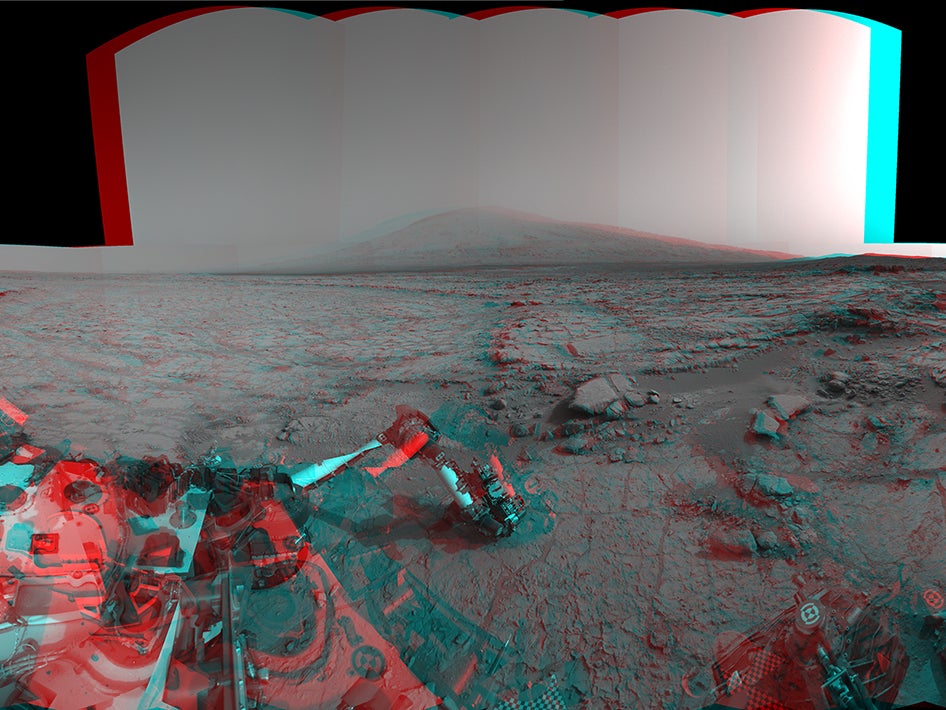Follow your nose to find life on Mars
Methane on Mars? Earlier methane indication suggested existing life or recent life underground, but newer data from the Mars Rover Curiosity fail to substantiate the finding. The real mystery is why the Curiosity study contradicts earlier studies from earth and Mars orbit. Comet ISON passes directly over Mars tomorrow on its way into center of the Solar System. ISON is now visible in a moderate-sized telescope but FAILING in its expectations of performance. Mercury very low in the west at sunset but Venus and Saturn are much easier targets all week 30 minutes after sunset. Jupiter rises by midnight now, Mars at 3:15 am and well up in the East south-east at sunrise.
September 30, 2013
[Dave Heller] A potential indicator of possible life on Mars is or is not detectable. Well let’s follow our noses with Derrick Pitts, chief astronomer at the Franklin Institute. Ah, Derrick: the unmistakable aroma of methane …
[Derrick] Mmmm… we can smell it everywhere here on this planet, and that’s a good thing because it’s a great indicator that there is life here. The most obvious way that most of us might think of the presence of methane here comes from the lovely bovine world of cows who provide plenty methane through their feeding and digestive systems. So we can use this as an indicator for life on other planets. In fact, scientists have not ignored this at all. When we consider the possibility of life on planets beyond Earth, even outside of our solar system, one of the signatures in an atmosphere of an extra solar planet we might look for is methane as an indicator of the metabolic processes that convert some material into energy and then the waste by-products, in this case the gas form, of methane.
When we look at the planet Mars, this is one of the indicators that might be used to identify whether or not there is life currently on Mars, and whether or not there was life on Mars in the past if we can find methane / methane-compounds bound into the rock materials or in any other aspect of the environment. There were a series of tests done a few years ago that indicated that indeed there was a significant — “significant” not being all that high an amount, but at least several parts per billion — of methane found in the very, very thin Martian atmosphere. This led some scientists to hope that there was a much stronger possibility of present life on Mars.
“There were a series of tests done a few years ago that indicated that indeed there was a significant — “significant” not being all that high an amount, but at least several parts per billion — [amount of] methane found in the very, very thin Martian atmosphere. This led some scientists to hope that there was a much stronger possibility of present life on Mars.”
Derrick Pitts
And indeed present life on Mars, because we’re not talking about an artifice from millennia ago.
No, we’re actually talking about existing life right now on Mars. So there was a hope that this was a strong indication of that possibility. Now having put the Mars Science Laboratory on the surface so that the testing can be done in situ right there on the surface with much better instrumentation than was available before, the latest results indicate that the amount of methane is 1.33 parts per billion — far lower than originally expected. And a much weaker indication of this possibility that perhaps there’s some life on Mars. In fact, the way it’s being interpreted now is that this tiny, tiny amount does not really indicate the possibility of current life on Mars.
-

Mars Stereo View from ‘John Klein’ to Mount Sharp, Raw: Left and right eyes of the Navigation Camera (Navcam) in NASA’s Curiosity Mars rover took the dozens of images combined into this stereo scene of the rover and its surroundings. The component images were taken during the 166th, 168th and 169th Martian days, or sols, of Curiosity’s work on Mars (Jan. 23, 25 and 26, 2013). The scene appears three dimensional when viewed through red-blue glasses with the red lens on the left. It spans 360 degrees, with Mount Sharp on the southern horizon.
OK, no cows on Mars for now, but there is a sign up for a comet crossing this week.
Yes, coming up tomorrow Comet ISON passes pretty close to Mars, right over top of the planet, right on its way toward the center of the solar system. This is probably the first big milestone of the comet’s passage through the center of the solar system that we can really pay attention to. Comet ISON was actually visibly close to Mars in the evening sky this past weekend. And since it’s continuing in its motion in toward the center of the solar system, its position is changing our position relative to Mars, the comet and the sun are also changing, so all these factors put together will make the comet appear to be moving through the sky bit by bit, day by day. So if you were to try to take a look at it in the predawn sky where Mars is found, it would take a moderate-sized telescope to see the comet. Yet, we do know it’s on its way in.
If we wait a little longer will it be coming close to planet Earth?
Yes, it will be coming closer to planet Earth so we’ll get a good view of it later into November and through early December. Of course the really big question is: what will it look like? When we began the first discussions about Comet ISON as being a major astronomical event — we started those discussions earlier in the year — the hope and some indication was that it would be a really spectacular object that everyone could see a potential “Comet of the century!” Well, as we now continue to follow it on its way into the center of the solar system, we’re now beginning to see that perhaps we were a little bit over-optimistic about what its appearance would be like. So right now it’s looking like it will be visible in both the predawn sky and the evening sky into November and on into December. But the stories about how bright it will be should probably be muted to a degree; visible, mmm… some with the naked eye, more likely with good binoculars and a telescope. But at least it will be visible, just not at the spectacular level that it was originally predicted appear.
However, having said all this, comets are notorious for changing what their appearance can be. One of the questions we ask is: will the comet break up due to gravitational pull from the sun before it makes its closest approach to the sun, or afterward? If it breaks up before its closest approach to the sun, that means its brightness after it passes will not be very high. But if it breaks up after it passes around the sun, then that could indicate that we’ll have much brighter appearance. So these are things that still have to be determined as time goes on.
-
The movie shows a sequence of Hubble observations taken over a 43-minute span and compresses this into just five seconds. The comet travels 34,000 miles in this brief video, or 7 percent of the distance between Earth and the moon. The deep-space visitor streaks silently against the background stars.
Guide us then for prime time for viewing other night sky treats this week.
Well as it works out in the evening sky this week, right now Venus and Saturn are the primary targets. Both are relatively bright and easy to see 30 minutes after sunset. Mercury is also there, much lower toward the western horizon. As the week goes on though, Mercury will creep up higher and higher from the western horizon, joining the other two. So we’ll have the three of them in the evening sky by the end of this week, early next week. Around in the predawn sky the largest planet of the solar system, Jupiter, is rising at about midnight now. So you can either stay up late or get up early in the morning when it’ll be high in the eastern / southeastern sky. But at around 3:15 a.m., Mars is rising above the eastern horizon as well. Comet ISON is there but you’ll need a moderate sized telescope to see it.
WHYY is your source for fact-based, in-depth journalism and information. As a nonprofit organization, we rely on financial support from readers like you. Please give today.





